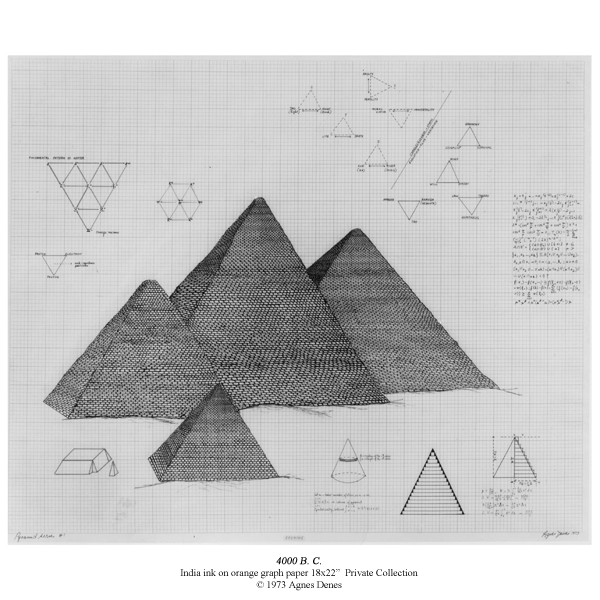The Pyramids weave in and out of my work from the very beginning in diverse forms dealing with a great variety of issues important to humanity. Each form and concept represents an enigma, something to which we must respond. These forms are visual philosophy that convey ecological, social and cultural issues in a multitude of shapes. Every pyramid and every form seeks a purpose, poses a question and seeks an answer for humanity. They all deal with the present and the future.
The Predicament represents our society with thousands of tiny people who sit in protected isolation without privacy, believing in the illusions of freedom without having any. They represent alienation in togetherness and uniqueness in uniformity,
There are real pyramids and exotic ones, imaginary and philosophical, they represent logical structures, architectural innovations and society building. They represent the past and the possible future we will invent. Some pyramids are not exactly pyramid shaped and their meaning spans all of human existence.
They may depict a society in the process of tampering with its destiny, with comparisons made to the rise and fall of previous advanced societies that have interfered with their evolution. The Restless Pyramids create Self-Supporting City Dwellings that can sustain their inhabitants, and Space Stations and other pyramids of the future for space travel with flexible, self-regenerating and easy to repair units. This is the birth of giant Fish Pyramids for creating underwater habitats, or pyramids in the shape of an egg or a teardrop. They are created for a different world in which the inhabitants will live in space, hovering above Earth, or else live on Earth in self-contained, self-supporting environments. These structures are not science fiction, they are the product of high technology, yet another "perfection", that of the flexibility of natural systems. They have a look of freshness and vulnerability. They are the future and the future is always vulnerable and unused.
Some pyramids form matrices that embrace logical symbols, permutations working out human theoretical concepts, and there are those that represent irony or beauty like the Crystal Pyramid, a massive edifice with its millions of reflections.
The materials of the pyramids are diverse as well, they can be stone, etched glass, plantings and even silk. They can be invisible as thought processes, logic and mathematics; or trees when they form a forest; conceptual, shaped like a nautilus when a future city; motion when they seem to awaken; birds when they fly; history when they probe the ancients.
Some pyramids contrast civilizations, others tackle linguistics, some seek origins, the power of nature's innocence and of true beginnings. Some depict the human predicament, and the glory of accomplishments, traditions and overcoming them. Some are made of tiny individuals who perform brilliant tasks, contrasting the magnificence of their collective accomplishments with the insignificance of the individual components. These are the Masterbilders who build the City of Fools. They map human parameters within the changing aspects of reality and their mathematics represent our striving for perfection, and what's most endearingly human, our weaknesses and flaws.
Some pyramids float in apparent weightlessness, while others are made of the weight of conscience. But what they all convey is the human drama, our hopes and dreams against great odds. They represent the paradoxes of existence and like grand mandalas, define our destiny.
© Agnes Denes 2005






